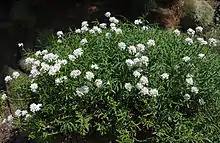Iberis
Iberis /aɪˈbɪərɪs/,[1] commonly called candytuft, is a genus of flowering plants belonging to the family Brassicaceae. It comprises annuals, evergreen perennials and subshrubs native to the Old World.[2] The name "candytuft" is not related to candy, but derives from Candia, the former name of Iraklion on the Island of Crete.[3]
| Iberis | |
|---|---|
 | |
| Perennial candytuft (Iberis sempervirens) | |
| Scientific classification | |
| Kingdom: | Plantae |
| Clade: | Tracheophytes |
| Clade: | Angiosperms |
| Clade: | Eudicots |
| Clade: | Rosids |
| Order: | Brassicales |
| Family: | Brassicaceae |
| Genus: | Iberis L. |
| Species | |
|
~30; see text | |
In the language of flowers, the candytuft symbolizes indifference.[4]
Species
Iberis consists of about 30 species of annuals, perennials and evergreen subshrubs. Some of the better known are:
Iberis amara - rocket candytuft, bitter candytuft, wild candytuft
Iberis ciliata
Iberis gibraltarica - Gibraltar candytuft
Iberis linifolia
Iberis procumbens - dune candytuft
Iberis saxatilis - rock candytuft
Iberis sempervirens - evergreen candytuft, perennial candytuft
Iberis umbellata - globe candytuft
They are used as ornamental plants for rock gardens, bedding, and borders in full sun or light shade.
Trophic connections
These plants provide nourishment for a number of insect species of which the rare Euchloe tagis butterfly is the most striking example as it is monophagous on species in this genus. [5][6]
Biochemical defenses
Species in the genus Iberis contain not only glucosinolates, which are characteristic chemical defenses of the Brassicaceae plant family, but also cucurbitacins,[7] which are better known as chemical defenses in the Cucurbitaceae plant family. Cucurbitacins from Iberis amara have antifeedant activity against the Brassicaceae-feeding specialist Pieris rapae (cabbage butterfly).[8] Cucurbitacins from Iberis umbellata (globe candytuft) are ecdysteroid antagonists, acting on the ecdysteroid receptor of insects.[9]
References
- Sunset Western Garden Book, 1995:606–607
- RHS A-Z encyclopedia of garden plants. United Kingdom: Dorling Kindersley. 2008. p. 1136. ISBN 978-1405332965.
- Shorter Oxford English dictionary, 6th ed. United Kingdom: Oxford University Press. 2007. p. 3804. ISBN 978-0199206872.
- "Language of Flowers - Flower Meanings, Flower Sentiments". www.languageofflowers.com. Retrieved 2016-11-26.
- de Viedma, M. G.; Escribano, R.; Gómez-Bustillo, M. R.; Mattoni, R. H. T. (1985-01-01). "The first attempt to establish a nature reserve for the conservation of lepidoptera in Spain". Biological Conservation. 32 (3): 255–276. doi:10.1016/0006-3207(85)90113-2. ISSN 0006-3207.
- Marabuto, Eduardo; Pina-Martins, Francisco; Rebelo, Maria Teresa; Paulo, Octávio S. (2020). "Ancient divergence, a crisis of salt and another of ice shaped the evolution of the west Mediterranean butterfly Euchloe tagis". Biological Journal of the Linnean Society. 131 (3): 487–504. doi:10.1093/biolinnean/blaa129. hdl:10451/45515.
- Nielsen, Jens Kvist; Larsen, Lone Melchior; Søorensen, Hilmer (1977-01-01). "Cucurbitacin E and I in Iberis amara: Feeding inhibitors for Phyllotreta nemorum". Phytochemistry. 16 (10): 1519–1522. Bibcode:1977PChem..16.1519N. doi:10.1016/0031-9422(77)84014-4. ISSN 0031-9422.
- Sachdev-Gupta, Kusum; Radke, Celia D.; Renwick, J. Alan A. (1993-08-12). "Antifeedant activity of cucurbitacins from Iberis amara against larvae of Pieris rapae". Phytochemistry. The International Journal of Plant Biochemistry. 33 (6): 1385–1388. Bibcode:1993PChem..33.1385S. doi:10.1016/0031-9422(93)85096-A. ISSN 0031-9422.
- Dinan, Laurence; Whiting, Pensri; Girault, Jean-Pierre; Lafont, René; Dhadialla, S. Tarlochan; Cress, E. Dean; Mugat, Bruno; Antoniewski, Christophe; Lepesant, Jean-Antoine (1997-11-01). "Cucurbitacins are insect steroid hormone antagonists acting at the ecdysteroid receptor". Biochemical Journal. 327 (3): 643–650. doi:10.1042/bj3270643. ISSN 0264-6021. PMC 1218839. PMID 9581538.
External links